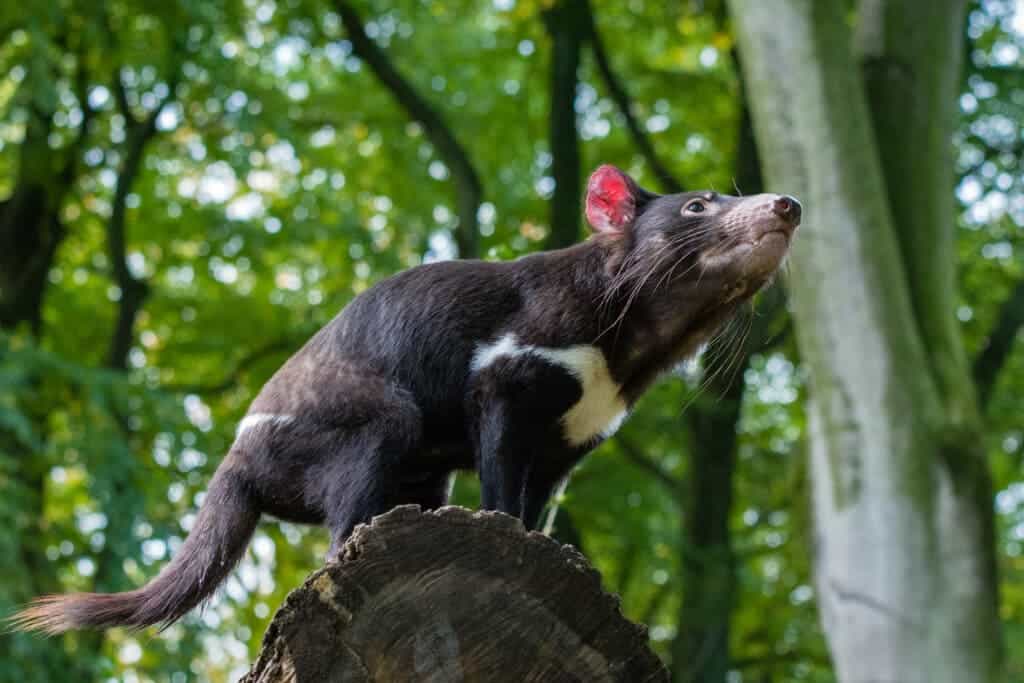
As the largest carnivorous marsupial in the world, the Tasmanian devil is strictly carnivorous, hunting frogs, birds, fish, and insects. But most of their meals actually consist of carrion. Yet Tasmanian Devils aren’t your typical scavengers that will devour anything they get their teeth on. Much to everyone’s surprise, researchers in Australia found that the devils have very specific tastes and dietary preferences, which furthermore can vary from individual to individual. That’s rather unheard of for scavengers but the rowdy devils are not ones to play by the rules.
“It’s a scavenger’s job to just be a generalist and take whatever it can find,” says Tracey Rogers, senior author of the study and a Professor at the School of Biology, Earth and Environmental Studies at the University of New South Wales.
“But we’ve found that most Tasmanian devils are actually picky and selective eaters—they’ve broken the laws of scavenging.”
Scavengers, also called carrion-feeders, are animals that feed partly or wholly on the bodies of dead animals. Vultures, crows, and hyenas are among the most famous scavengers in the animal kingdom, playing an important role in the food web by keeping the ecosystem free of carrion and recycling organic matter into ecosystems as nutrients.
One of the reasons scavengers have a place in the food web, somewhere between prey and predator, is that they are very flexible about what they eat. The American crow will eat mice, eggs, seeds, and nuts, for instance, making them highly adapted to virtually any environment, be it the wild or sprawling urban areas.
Part scavengers, Tasmanian devils have always been thought to eat just about anything — but it turns out they’re pickier than a toddler.
Anna Lewis, the lead author of the study and Ph.D. candidate at UNSW Science, laid traps in the island of Tasmania for a week at a time, catching around 10 devils per day. In total, they captured 71 individuals across seven different sites, from which they removed small whisker samples before releasing them back to the wild. Each bristle is embedded with isotopes from the food the devils ate in the past, thus revealing their diets.
Just around one in ten devils had a generalist diet, consisting of whatever food was available in their habitats. Most devils, however, chose to eat their favorite foods, such as wallabies, possums, and rosellas, and turn up their noses at unappealing carrion.
The heaviest devils also proved to be the pickiest eaters. This could mean either that size is a driving factor in their food choices or, alternatively, specializing in certain types of carrion helps them gain weight.
What’s more, there was a great deal of variation among individuals. Just like humans, individual devils have their favorite meals.
“We were surprised the devils didn’t want to all eat the same thing,” said Lewis in a statement.
“Most of them just decided, ‘No, this is my favorite food.'”
Lewis and colleagues go on to add in their study published in Ecology and Evolution that this behavior seems to be devil-specific. Sure, there may be other scavengers that are non-generalists, but we’ve yet to find others.
Other scavengers can’t afford the luxury of saying ‘no thanks!’ to whatever carrion comes their way. Vultures in Africa, for instance, have to compete with myriad other predators and scavengers for food. Once they smell carrion, they’ll swoop right in, no questions asked. Check, please!
But in Tasmania, Tasmanian devils are virtually at the top of the food chain, with little competition for carcasses. “Their main competition is just with each other,” said Professor Rogers.
Arcturus, one of the devils from the study, named after one of the brightest stars in the sky, likes to eat pademelon and wallabies. But every once in a while, he decides to go for something different, indulging in a snake or two.
“Tasmanian devils are these really cool scavengers that are doing something completely different to every other scavenger in the world,” says Ms. Lewis.
“We’re lucky to have them here in Australia,” she added, hoping to keep it that way. The numbers of Tasmanian devils have plummeted since the 1990s due to a variety of reasons, chief among them a serious epidemic called Devil Facial Tumor Disease (DFTD).
It’s only one of three transmissible cancers known to man (the other being in dogs and shellfish), but also one of the most unforgiving, having an almost 100% kill rate. Today, the population of the iconic Australian marsupial is down 90% and many researchers fear the devil may be doomed unless something is done about it — and fast.
Until scientists develop a viable treatment or vaccine for DFTD, conservation groups have focused on minimizing interactions between populations, even opting for capturing some devils until it’s safe to release them back into the wild. Dietary studies such as these may help inform conservationists what kind of diets the devils respond best to in order to maximize their odds of survival in captivity.
“From a conservation perspective, the findings could help us work out if we’re feeding devils the appropriate thing in captivity,” says Ms Lewis.
“At the moment, there’s a long list of foods that devils can eat, but it’s not specific in how often they eat all those foods or whether most only focus on a few different food types.”









